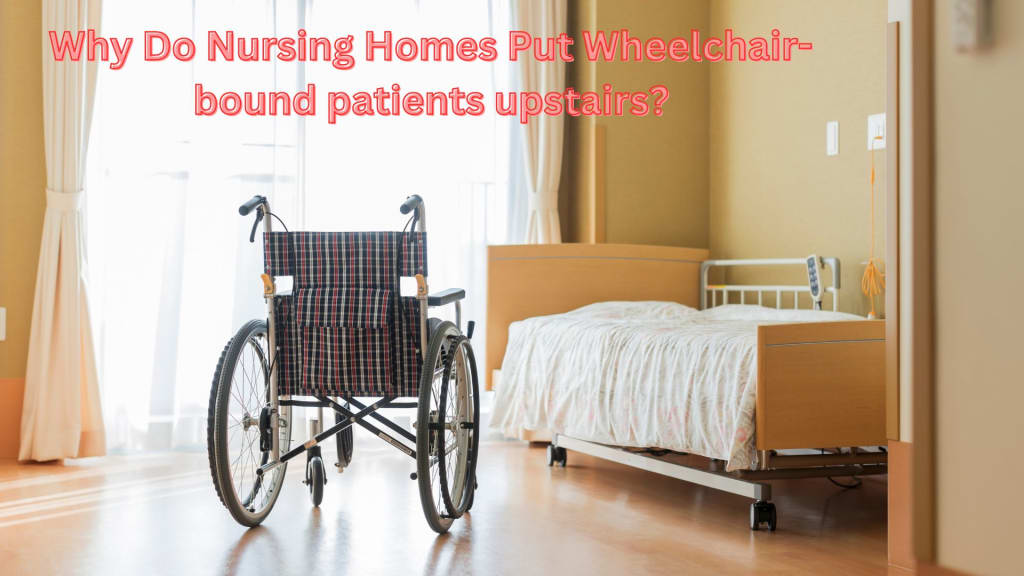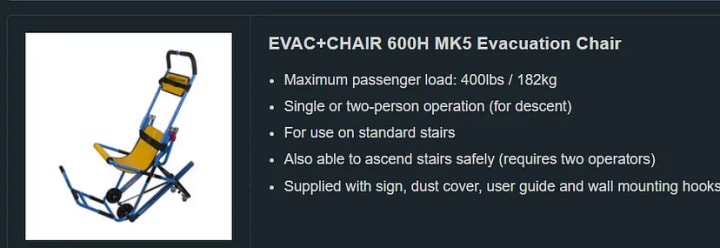The Truth About a Nursing Home Fire Outbreak Revisited
Why the obsession of always putting wheelchair users right on top floors

I chose to author this after this very question has been plaguing me for too many years. I had been a registered nurse for 32 years before I had to medically retire after becoming physically disabled from contracting COVID-19 in 2020 whilst working in a hospital where I had been employed full-time.
This question.
“Why are wheelchair and bedbound patients in nursing or care homes always placed in rooms on top floors when living there?”
It is a question I have asked nursing homes and regional managers many times before. Quite surprisingly their responses were never easily forthcoming, filled with quite vague reasons, and their facial expressions told me that (non-verbally) they were made to feel uncomfortable with my questioning.
According to Nursing Home Law Center, LLC., it is stated that “…allowing a nursing home patient to sit comfortably in their wheelchair in a hall or in an outdoor area of the facility seems like a pretty innocent act– right? Aren’t patients in wheelchairs entitled to a little fresh air or just hang out in a communal area with other patients?”
The answer in my mind straight away to this is “YES, of course, they are, after all, every single person who needs to live in any care facility is a living, breathing human being are they not?”
Yet nursing homes continue to allocate their bedrooms to the top floors.
Able-bodied patients are always allocated to the ground floor.
WHY?
Let me give you a bit of information about the fire regulations and fire procedural actions that are in place for nursing homes.
For every registered nursing home situated within Britain, it is mandatory for them to closely adhere to the following two orders.
The Regulatory Reform (Fire Safety) Order 2005
Health and Social Care Act 2008
Fire Evacuation Procedure in a Nursing/Care Home.
Every fire situation is different. Therefore, each care home premises will need to devise its own personalized fire evacuation procedure. In care premises, evacuations fall into three categories:
Single stage: If all residents are deemed independent for the need to be helped, all residents can evacuate immediately with minimal assistance.
Progressive horizontal: Occasions when most residents are dependent on staff assistance for a successful evacuation. This may have to be done in stages, first moving residents from fire zones to safe zones, and finally to outside of the premises.
Delayed: In some cases, it is potentially dangerous to immediately evacuate certain residents who have complex needs. Instead, they may be allowed to remain in their rooms while the fire is put out. These are rare cases, and often additional structural precautions in these patients’ bedrooms may have to be considered.
Whatever the fire evacuation plan in your residential care home, speed, and safety are the main priorities.
It is true, just like every person I have worked with, I know these rules like I know the position of every key on this keyboard I’m tapping on right now… blindfolded.
During one of the last fire safety training sessions, I was involved in before I was medically retired (at 50) I was advised that (as the senior nurse in charge) part of my responsibilities was to make some tough decisions quickly, in the event of a fire, the fire officer directly told me the following -
“If you cannot safely get one of your wheelchair or bedbound residents out of the immediate danger zone (the fire floor) then you must think of your safety and your colleague’s safety above all else. Ensure that your resident who cannot safely and rapidly be evacuated, is left in their room with their door firmly shut (the door has a fire-safe life of 60 minutes) so get out of the building, tell us when verbally reporting the fire outbreak that you have disabled vulnerable persons that you cannot move, and we will go and retrieve them when we arrive on scene first, while other crews arriving will carry out full searches, and tackle the blaze.”
Those words weighed heavily on me for many years until the day arrived, when the nursing home I was currently working in, really did catch fire.
Below is a typically available example of an evacuation chair that we had available in our nursing home, which was readily available by our stairs to rapidly get our wheelchair residents down to the ground floor.

Below is a typically available example of an evacuation stretcher that we had available in our nursing home, which was readily available by our stairs to rapidly get our bedbound residents from their rooms, and safely & securely down the stairs to the ground floor.

However, in some emergency situations like the one where my colleagues and I were faced, the fire outbreak was too rapid, had broken out on the same floor, and the safety risks were too high to attempt a resident rescue for us.
I made the rapid but extremely hard decision, to close the door with the resident, left in their room upstairs.
Now okay, yes, the fire department was made aware of this, and I once more urgently advised the fire officer-in-charge who attended the scene, of ‘a person reported as immobile and left behind bedroom fire door on floor four, room thirty-eight.’
An immediate on-scene rescue was made successfully (on this occasion) and the immobile resident was rescued, brought safely out of the building, and given emergency on-site care.
But this left me with an extremely bitter thought in my mind -
“What if that resident had not been rescued by the fire rescue team in time before the fire had burned through that door?”
It could have been a lot worse.
That innocent immobile person could have died there and then.
Following my debrief by both the fire team and the nursing home regional director, I was told that I had done everything ‘by the book’ and had safely ensured that all residents and staff had been evacuated, accounted for, and were all safe because of my actions during the major fire incident.
But this still leaves me with one big question-
“Why put wheelchair and bedbound people on the top floors of nursing and care homes?”
WHY put a human life at unnecessary risk, when they could easily be allocated a bedroom on the ground floor?”
Ever since leaving my nursing career behind, I still ask myself this question every so often.
The reason is starkly clear.
Because no home manager or regional director could not, or would not, answer that question I put to them.
“Why are wheelchair and bedbound patients in nursing or care homes always placed in rooms on top floors when living there?”
Can you, reading this today, even answer that one?
Probably not but let me tell you this bit.
In my time working in these areas, when a new potential person is coming to look around the home, or a close relative wants to look around, who are having to finally place their loved one into the capable, caring hands, of a nursing home, what is the first thing on the nursing home managers mind?
Is my home clean and tidy?
Is it presentable?
Now you may be thinking that I am ‘overthinking’ but trust me I am not, I have witnessed these moments too many times to mention.
I have overheard many regional directors tell me and the home managers, “he uses a wheelchair, so please allocate a top-floor bedroom,” or “… she is bedbound so put her upstairs.”
The worst is yet to come…
One regional director was heard telling the home manager and me this-
“I do not like them on the ground floor where potential new clients can see them, I want them to see a lovely bright area with residents walking around smiling, watching a film and enjoying a coffee, chatting with other likewise residents, not seeing wheelchairs.”
For pity’s sake, he seriously needed to wake up and smell the flowers, see the reality, and notice that they were human.
That regional manager did not last long in his position after he was reported to the Care Quality Commission (CQC) shortly after the fire outbreak had occurred.
It turned out that he just wanted to make substantial amounts of money, so he got his bonus payment for filling his empty nursing home beds. Not surprisingly he ended up not getting it… he was sacked because he cared too much about the money and the aesthetics of the ground floor areas…
This is abuse in no uncertain terms.
Thank you for reading this and please let me know your thoughts. Writing this has truly helped me by sharing this with you all.
********

If you fancy tipping me or pledging your support in these ways too then I'll have to hug you🤣😊.
Tips are a wonderful way of showing your support to me and they really help me in continuing my writing journey, and are amazing to get😍👍...
More of my articles can be found by clicking on my profile page. If you are feeling adventurous and creative, then why not join us at the Vocal+ platform by clicking on this here?
Or why not come and chat with me over on Medium too, where I also write
About the Creator
Jonathan Townend
I love writing articles & fictional stories. They give me scope to express myself and free my mind. After working as a mental health nurse for 30 years, writing allows an effective emotional release, one which I hope you will join me on.






Comments (6)
"I had to medically retire after becoming physically disabled from contracting COVID-19 in 2020" This is an issue in itself. I am sorry to hear this, Jonathan. Did you write anywhere about this?
" ... potential new clients" this kind of thinking to refer to patients is incredibly disgusting in my view. The lack of compassion, empathy, and humanity is simply something hard to comprehend. When I think I have seen enough of the worst of humanity, this. How on Earth do they get away with it? When did this actually happen? I know you said it took you a while to get the courage to take it out of your system in the form of writing about this horror. And I know it was before 2020. But when exactly and where?
I had no idea this was happening. I personally find it rather stupid and utterly irresponsible toward the patients who depend on others for their mobility to place them upstairs, knowing well they will not be able to exit the building by themselves in case of emergency. Was this reported to authorities at the time?
Nice work great writing ❤️❤️ I’m new here so I’ve just dropped a few 😮💨
I had no idea this was going on. Thank you for the insight (a lot to consider...)
I recently read a story that I found incredibly heartwarming and inspiring. The characters were well-developed, and the plot kept me engaged throughout. What I appreciated most was the author's sensitivity and care in addressing difficult themes. I feel grateful to have come across this story and am excited to share it with others. You can also join my friends and read what I have just prepared for you. Read less